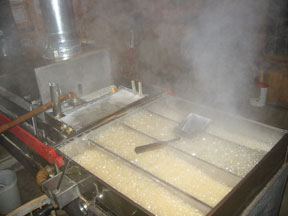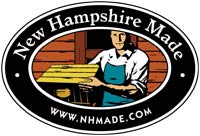Sugar Season
In southern New Hampshire, sugar season starts in mid-to-late February and generally lasts through March. This is the time of year when weather conditions will cause the sap to “run”. Warm days of 40 degrees coupled with cold nights in the 20′s are ideal to get the sap flowing in the trees.
 We have a 500 tap operation in Chester. All our taps are done with buckets, which supply our 3-foot x 8-foot wood-fired evaporator. In late January to early February we start checking the long range weather forecasts to see when the weather will look good for the first “run”. Brian usually takes 2-3 days to tap out. This means a small hole is drilled about 1 1/2” – 2” into the sugar maple tree at a slightly upward angle so the sap will drip easily into the bucket. A spile is set gently but securely into the tap hole and a bucket is hung from the spile. A cover on the bucket helps keep out rain, snow, and debris from the trees.
We have a 500 tap operation in Chester. All our taps are done with buckets, which supply our 3-foot x 8-foot wood-fired evaporator. In late January to early February we start checking the long range weather forecasts to see when the weather will look good for the first “run”. Brian usually takes 2-3 days to tap out. This means a small hole is drilled about 1 1/2” – 2” into the sugar maple tree at a slightly upward angle so the sap will drip easily into the bucket. A spile is set gently but securely into the tap hole and a bucket is hung from the spile. A cover on the bucket helps keep out rain, snow, and debris from the trees.
On days when the sap flows, we have 18 to 20 locations around town from which the sap is collected. A 210 gallon gathering tank in the back of our truck holds the sap which is collected from the buckets with a gathering pail, carried back to the truck and then brought to the sugarhouse. It often takes 3 to 4 trips to collect the 600 to 800 gallons from a good days run. It’s approximately 25 miles to drive the route.
At the sugarhouse we have a stainless steel 300 gallon tank in the loft of the sugarhouse that feeds the sap into the evaporator. Extra sap is stored in another 500 gallon stainless tank outside. Once collected, sap needs to be processed as soon as possible in order to produce the best syrup possible. It takes an average of 40 gallons of sap to produce 1 gallon of pure maple syrup.
Our evaporator boils about 60-70 gallons of sap an hour so we average making about 1 – 1.5 gallons of syrup per hour. That means about 10 hours or more of boiling after each run. The sap is boiled to concentrate the 2% sugar in the raw sap to a sugar density of 66.5%. At this point it is maple syrup and can be filtered and graded for packaging. Filtering is done using a filter press which contains seven filtering chambers to remove all the unwanted minerals or nitre from the syrup.
Once filtered a sample bottle of the syrup is placed in a grading kit to determine if the syrup can be called Grade A Golden – Delicate taste, Grade A Amber – Rich taste, Grade A Dark – Robust taste or Grade A Very Dark – Strong taste. Additionally each sample must be tasted to assure it has a pure maple flavor with no off flavors. These standards are set by the U.S. Department of Agriculture and the State of N.H. Department of Agriculture. The syrup is then hot packed at 190° F into the various containers in order to assure a sterile seal.
Once you have made the syrup you can make other maple products like cream, candy, taffy and dry sugar. These are all pure maple products simply taken further in the evaporation process and are chilled and/or stirred to create the desired products.
We are a proud member of the New Hampshire Maple Producers Association.

